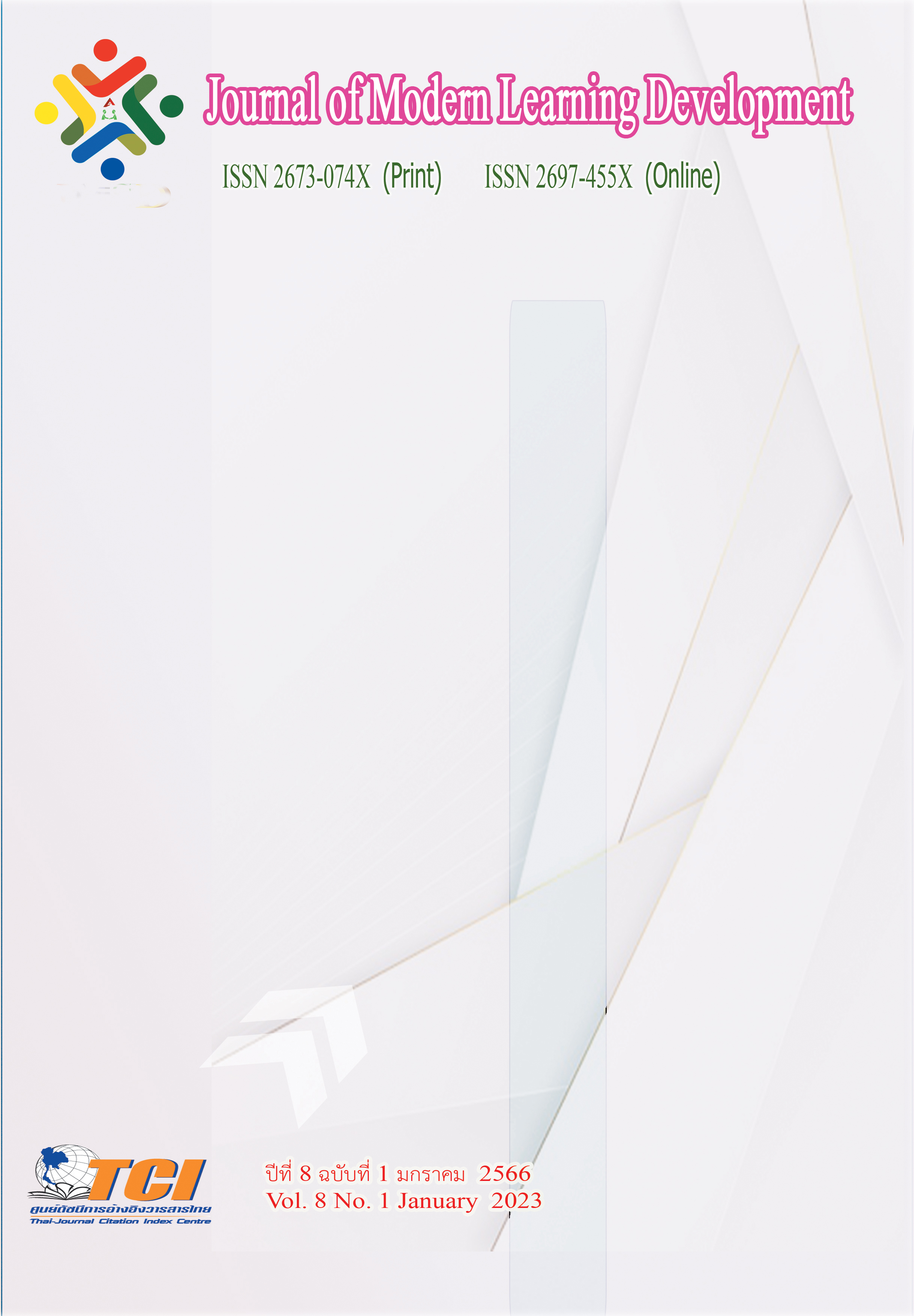Model of Vipassanã Kammatthanã Teaching of the Dhamma Retreat in Nakhon Ratchasima Province
Main Article Content
Abstract
This research consisted of 3 objectives as follows: 1) to study the condition of Vipassanã Kammatthanã teaching in Buddhism 2) to study the model of Vipassanã Kammatthanã teaching of the Dhamma retreat in Nakhon Ratchasima province 3) to present the model of Vipassanã Kammatthanã teaching of the Dhamma retreat in Nakhon Ratchasima province. It is mixed methods between qualitative research and quantitative research which designed 2 parts were documentary study and field study. The key informants/Sample consisted of 36 monks/Dhamma practitioners which attended to 2 sects were Maha Nikaya and Dhammayuttika Nikaya (Dhammayut Nikaya) from 9 Dhamma retreats/temples in Muang Nakhon Ratchasima district, Nakhon Ratchasima province, selected through the purposive sampling technique. The qualitative research instruments were: 1) in-dept Interview 2) focus group discussion 3) the quantitative research instrument was the questionnaire. The statistics were used for analyzing the collected data of the quantitative research were mean and percentage.
The results of the research is found as follows:
1. There are two conditions for teaching Vipassanã Kammatthanã in Buddhism are: 1)teaching the Samatha Kammatthanã 2)teaching the Vipassanã Kammatthanã from Anon’s four paths. It is the way to practice towards success by attaining the dhamma practitioners will be a noble individual namely; a) Samatha Puppapangkhama Vipassanã Kammatthanã is the practicing of Vipassanã by Samatha preceding it. b) Vipassanã Puppapangkhama Samatha Kammatthanã is the practicing of Samatha by Vipassanã preceding it. c) Samatha Vipassanã Yuknattha Kammatthanã is the practicing of Vipassanã and Samatha concurrently with an emotional state. d) Dhammutthatchawikkhahitmanat is the practicing only Vipassanã, in the case of Vipassanu Kilesa is born.
2. Model of Vipassanã Kammatthanã teaching of the Dhamma retreat in Nakhon Ratchasima province are: 1) The 5 Dhamma retreats/temples attended to Maha Nikaya teach the model of Vipassanã Kammatthanã teaching according to Satipatthãna 4: pray that Pong - hno Yup - hno as the principle. Overall, the results were interpreted at a very practical level with statistical values 𝒙̅ = 4.16 and 83.30 percent. 2) The 4 Dhamma retreats/temples attended to Dhammayut Nikaya teach the model of Vipassanã Kammatthanã teaching according to the Institute of Willpower: pray that Bud - dho as the principle. Overall, the results were interpreted at a very practical level with statistical values 𝒙̅ = 4.40 and 88. 00 percent.
3. The researcher presents the model of Vipassanã Kammatthanã teaching of the Dhamma retreat in Nakhon Ratchasima province: Model of Vipassanã Kammatthanã teaching based on Satipatthãna 4 or V1 to V5 Moddel with the five-steps teaching process and the abbreviation of them are; 1) Value receiving or V1 means a vipassanã teacher teaches the Dhamma practitioners abandon Pliboth, present themselves to ask for Kammatthanã meditation and lectures them for having the good attitude to practice Vipassanã Kammatthanã. 2) Value responding or V2 means he teaches them to do their main activities for the practicing of Vipassanã Kammatthanã; they are a) demonstrates the relaxing of bodily movement before the buddhist walking b) demonstrates the buddhist walking c) demonstrates the meditating. 3) Value valuing or V3 means he teaches them consider the base on Satipatthãna 4 are; Kãyãnupassana, Vedanãnupassanã, Cittãnupassanã and Dhammãnupassanã and consider the thoery of change for living that Pañca-Khandha is the characteristic of Tilakkhana. 4)Value organization or V4 means he lectures them that ought to practice the Dhamma for supporting Vipassanã Kammatthanã which is 5 controlling faculty/5 power, The noble eightfold path is associated with the threefold path, abandon 5 hindrances and 10 fetters. 5) Characterization by value or V5 means the step of assessment, he teaches them to send the emotion, gives them the emotional test, feedback and they practice Vipassanã Kammatthanã at their temples/home in daily life.
The outflow of good result is the Dhamma practitioners has The Threefold Trainning is; higher morality, higher mentality and higher wisdom. They can see The Four Noble Truths; can solve the life problems in detail, neither pleasant nor painful feeling from relieve the fetters until abandon the 5 hindrances and 10 fetters or at least 3 fetters are; personal view, doubt and adherence to rules and rituals. They will be the first noble individual is Sotãpanna.
Article Details
References
จุฑาภัค หริรักษ์ธํารง. (2560). รูปแบบการบรรลุธรรมในพุทธศาสนาเถรวาท. ดุษฎีนิพนธ์พุทธศาสตรดุษฎีบัณฑิต สาขาวิชาพระพุทธศาสนา. บัณฑิตวิทยาลัย : มหาวิทยาลัยมหาจุฬาลงกรณราชวิทยาลัย.
ชวลิต ชูกำแพง. (2553). การวิจัยหลักสูตรและการสอน. (พิมพ์ครั้งที่ 2). มหาสารคาม: มหาวิทยาลัยมหาสารคาม.
ชัยชาญ ศรีหานู. (2559). รายงานวิจัยย่อยที่ ๔ การปฏิบัติ และการสอบอารมณ์กรรมฐาน ตามหลักพระพุทธศาสนาเถรวาทในประเทศลาว. รับทุนอุดหนุนการวิจัยจากมหาวิทยาลัยมหาจุฬาลงกรณราชวิทยาลัย. นครปฐม : มหาวิทยาลัยมหาจุฬาลงกรณราชวิทยาลัย วิทยาเขตบาฬีศึกษาพุทธโฆส.
บุญชม ศรีสะอาด. (2553). การวิจัยเบื้องต้น. กรุงเทพมหานคร: สำนักพิมพ์ สุวีริยาสาส์น.
ประสาท เนืองเฉลิม. (2554). วิจัยการเรียนการสอน. มหาสารคาม: อภิชาติการพิมพ์.
พระกอบชัย เขมจารี (ปราบภัย). (2560). วิธีการสอนวิปัสสนาภาวนา : กรณีศึกษาพระมหาปาน อานนฺโทวัดมหาพุทธวงศาป่าหลวง นครเวียงจันทน์ สาธารณรัฐประชาธิปไตยประชาชนลาว. สารนิพนธ์พุทธศาสตรมหาบัณฑิต สาขาวิชาวิปัสสนาภาวนา. บัณฑิตวิทยาลัย : มหาวิทยาลัยมหาจุฬาลงกรณราชวิทยาลัย.
พระครูกัลยาณสิทธิวัฒน์. (2556). เอตทัคคะในพระพุทธศาสนา. กรุงเทพมหานคร: บริษัทสหธรรมมิก.
พระธรรมมังคลาจารย์ (ทอง สิริมงฺคโล). (2556). หลักปฏิบัติในการเผยแผ่พระพุทธศาสนา. (พิมพ์ครั้งที่ 2). เชียงใหม่: โรงพิมพ์แม็กข์พริ้นติ้ง.
พระพรหมคุณาภรณ์ (ป.อ. ปยุตฺโต). (2557). พุทธธรรมฉบับปรับขยาย. (พิมพ์ครั้งที่ 39). กรุงเทพมหานคร: โรงพิมพ์มหาจุฬาลงกรณราชวิทยาลัย.
พระพุทธโฆสเถระ. (2554). คัมภีร์วิสุทธิมรรค. แปล และเรียบเรียงโดย สมเด็จพระพุฒาจารย (อาจ อาสภมหาเถระ). (พิมพครั้งที่ 10). กรุงเทพมหานคร: บริษัทธนาเพรส จํากัด.
พระสิงหบุราจารย์ (หลวงพ่อจรัญ ฐิตธมฺโม). (2532). วิปัสสนากรรมฐาน เปลี่ยนชีวิต. กรุงเทพมหานคร: สำนักพิมพ์ธนชัยรุ่งเรืองพัฒนา จำกัด.
พระโสภณมหาเถระ (มหาสีสยาดอ). (2553). วิปัสสนาชุนี หลักการปฏิบัติวิปัสสนา (ฉบับสมบูรณ์). จำรูญ ธรรมดาแปล. กรุงเทพมหานคร: ห้างหุ้นส่วนจำกัด ประยูรสาส์นไทยการพิมพ์.
พระอาจารย์กัญหา สุขกาโม. (2553). สุขกาโมศิโรวาท. กรุงเทพมหานคร: บริษัท พรีมา พับบลิชชิง จำกัด.
พระอาจารย์มหาบัว ญาณสัมปันโน. (2556). ประวัติท่านพระอาจารย์มั่น ภูริฑัตตะเถระ. (พิมพ์ครั้งที่ 12). กรุงเทพมหานคร: บริษัทศิลป์สยามบรรจุภัณฑ์และการพิมพ์ จำกัด.
พระอุดมวิชาญาณเถร (โชดก ญาณสิทฺธิ ป.ท. 9). (2505). วิปัสสนากรรมฐาน เล่ม 4. กรุงเทพมหานคร: โรงพิมพ์อาศรมอักษร.
มหาจุฬาลงกรณราชวิทยาลัย. (2539). พระไตรปิฎกภาษาไทย ฉบับมหาจุฬาลงกรณราชวิทยาลัย. กรุงเทพมหานคร: โรงพิมพ์มหาจุฬาลงกรณราชวิทยาลัย.
ยุวดี พนาวรรต. (2559). การเสริมสร้างสุขภาพจิตผู้สูงวัยไทยด้วยวิปัสสนากรรมฐาน. ดุษฎีนิพนธ์พุทธศาสตรดุษฎีบัณฑิต สาขาวิชาพุทธจิตวิทยา. บัณฑิตวิทยาลัย : มหาวิทยาลัยมหาจุฬาลงกรณราชวิทยาลัย.
วิชชุดา ฐิติโชติรัตนา. (2559). การพัฒนารูปแบบการปรึกษาแนวพุทธจิตวิทยาบูรณาการของพระสงฆ์ที่มีบทบาทให้การปรึกษา. ดุษฎีนิพนธ์พุทธศาสตร์ดุษฎีบัณฑิต สาขาวิชาพุทธจิตวิทยา. บัณฑิตวิทยาลัย : มหาวิทยาลัยมหาจุฬาลงกรณราชวิทยาลัย.
โสวิทย์ บำรุงภักดิ์. (2563). ระเบียบวิธีวิจัยทางพระพุทธศาสนาและวิจัยชั้นสูง. ขอนแก่น: เอ็มมี่ ก้อปปี้ เซนเตอร์.
Primprao Disayavanish. (1994). The effect of Buddhist insight meditation on stress and anxiety. Ph.D. Dissertation : Illinois State University.
Sekaran, U. & Bougie, R. (2013). Research Methods for Business. (6th ed). Hoboken, NJ: John Wiley & Sons.
T.W. Rhys Davids and William Stede. (1997). Pali-English Dictionary. India: Motilal Banarsidass Publishers Private Limited.


